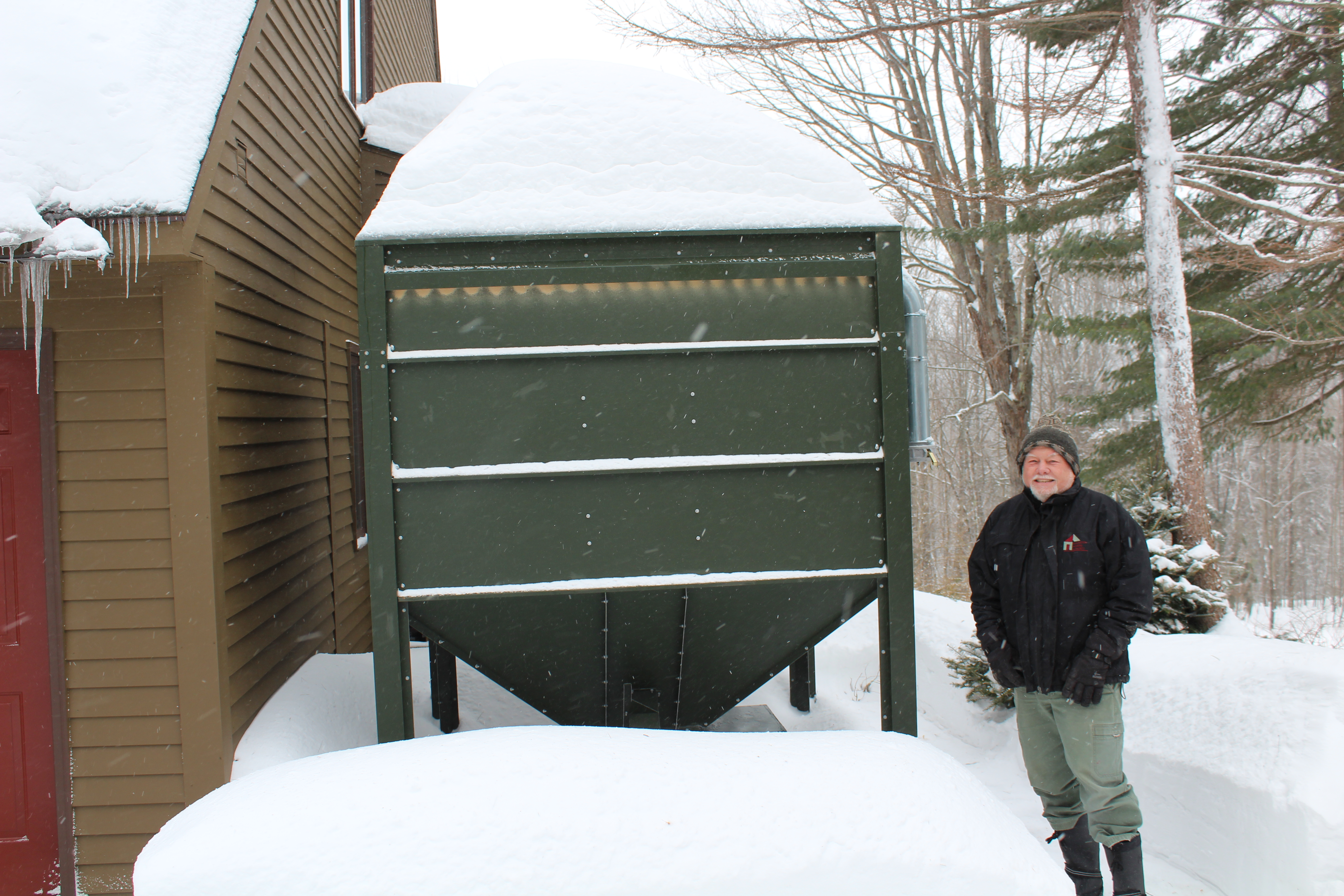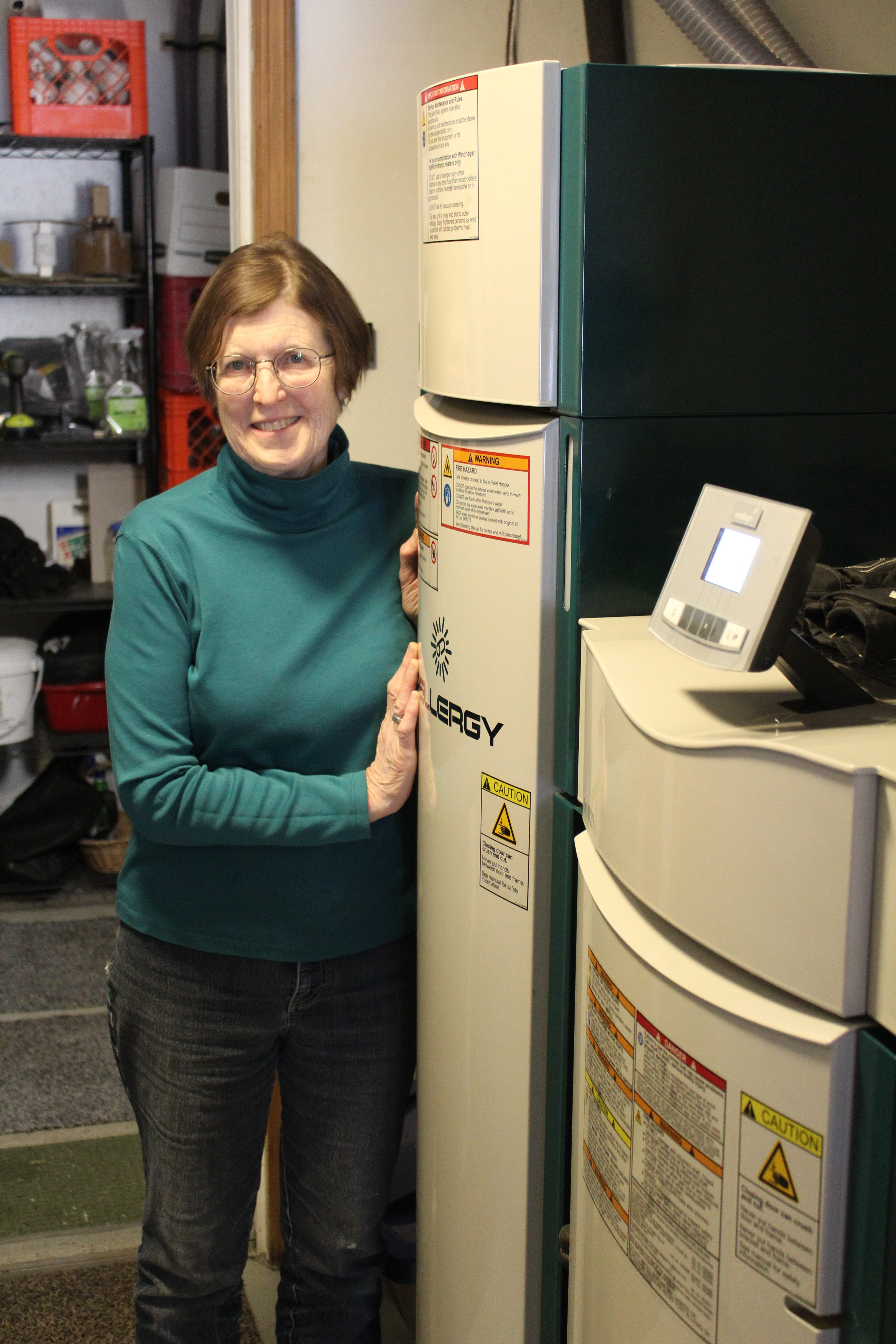Automatic pellet system gives WEC members convenient, clean energy
Just like local food helps the economy, when you use biomass, the money stays in the local economy because the resource supply is local. And it helps create a healthier forest, by managing the low-grade wood that can’t be used for durable wood products, essentially increasing the forest’s capacity to sequester carbon. – Dave Frank, SunWood Biomass
Back in 1986, when WEC members Paul Dettman and Mary Kasamatsu built their house on a hillside in Middlesex, they knew they wanted to heat efficiently, and with local wood instead of fossil fuels. They poured a massive slab with radiant heat. They cleared trees from their own lot, and then bought from a logger down the road. Chopping wood and loading the boiler “had been a fun family thing,” said Kasamatsu.
But in February 2018, after 32 years, their boiler died. The couple made it through the winter with backup electric heat while they figured out what to do next. They liked wood, but were ready to stop the heavy lifting and wanted the flexibility of an automatic system. Next to propane or fuel oil, advanced wood heating systems seemed expensive. “I was waffling. I didn’t want to go fossil,” said Dettman. “I said, if we didn’t [install a fossil fuel system] 30 years ago, why would we do it today?” pointed out Kasamatsu. The family had committed to sustainability, she said, and it seemed more important than ever to reduce their carbon use.
Ultimately, they settled on an advanced wood heating system. Working with Dave Frank, co-owner of SunWood Biomass, they installed a fully automatic system. And with the help of incentives, they saved $7,000.

On a cold day earlier this year, Paul Dettman stood beside his outdoor pellet storage bin. Just like a propane tank, when the pellet level starts getting low, it triggers a delivery of new pellets. “For someone who’s done wood heat all these years, I’m amazed. You don’t have to do anything,” said Dettman.
Economics of a new system
“Any home with a hot water heating system can convert or add on a wood pellet heating system. Or a home with hot air furnaces as well. Literally, almost any home can take on a wood pellet heating system,” said Frank, whose Fayston-based company has installed more than 300 advanced wood heating systems throughout New England. WEC is currently the only electric utility in Vermont to offer its members cash incentives for pellet systems. WEC contributes $1,000, in addition to $3,000 each from Efficiency Vermont and the Clean Energy Development Fund.
Those dollars help, because switching systems can get expensive. Incentives “bring the price somewhat closer, essentially making it an easier decision for the homeowner to go to a cost-saving, renewable energy heating system,” said Frank.
Dettman estimated the boiler itself cost about $10,000, and then in order to qualify for the Efficiency Vermont rebate, they needed a water tank to store the heat – which Dettman described as like a regular domestic hot water tank, only larger and more robust. “We’ve always had our slab be thermal mass for storage,” pointed out Kasamatsu – it was part of the initial efficient design of the home – but it didn’t qualify.
The tank was another expense, and at about six and a half feet high, it takes up a lot of space. Dettman and Kasamatsu closed off a small porch and poured a new slab in that area to house the tank. The couple also decided they’d use it for their domestic hot water. A stainless steel coil draws cold water up through the hot tank – by the time it’s piped out, it’s hot.
Without a basement, they also needed outdoor pellet storage. A three and a half ton bin outside is refilled by delivery truck when the pellets drop below a certain level – just like propane.
Dettman estimates the total cost of the project was about $10,950, after incentives but before associated costs, like the new slab and construction in the tank room. Others, for example, houses with suitable basement space, might not need to spend as much.
After the initial costs, Dettman, Kasamatsu, and others using advanced wood heat enjoy stable annual heating costs. “Wood stays pretty stable; fossil fuels fluctuate,” noted Dettman. Frank agreed – wood has been stable for more than 30 years, with increases only mirroring the rate of inflation, he said – and added, “We still are in and around 20 percent below fossil fuel prices.”
Big picture considerations

Mary Kasamatsu displays her indoor pellet bin and boiler.
Frank said there are bigger picture cost considerations. Pellet heat offers “lower and stabilized fuel prices, clean, a renewable energy source, and it is the equivalent of local food,” he explained. “When you use fossil fuel, 78 cents of every dollar leaves the state. But just like local food helps the economy, when you use biomass, the money stays in the local economy because the resource supply is local. And it helps create a healthier forest, by managing the low-grade wood that can’t be used for durable wood products, essentially increasing the forest’s capacity to sequester carbon.”
Another consideration is convenience. For homeowners like Dettman and Kasamatsu, stuck between reluctance to continue with the physical demands of wood – but with a strong distaste for fossil fuel – an automatic pellet system offered middle ground: fuel harvested locally and responsibly, requiring zero effort on the part of the homeowner. “For someone who’s done wood heat all these years, I’m amazed. You don’t have to do anything,” marveled Dettman.
How it works
Vacuums do the work. From the point of delivery, pellets are vacuum forced into the couple’s outdoor bin. A small indoor bin, about the size of a mini-fridge, is attached to the boiler. When pellets in that bin drop below a certain level, the boiler is triggered to shut off briefly while the vacuum system kicks in. Pellets are sucked from the outdoor bin to the indoor bin through a clear tube with an input behind some storage containers in the household’s new boiler room. The tube runs overhead and then down to the boiler. “We used to run out and see it when we heard it turn on,” laughed Kasamatsu. The novelty has since worn off, but they’re still excited about how well the system works. An augur brings pellets into the heating cup (a little larger than a quart yogurt container, said Kasamatsu), where they’re ignited. A screen on top of the boiler shows how long until the next cleaning, output levels, and the boiler temperature. Max is 170 degrees – in modulation mode, it’s at about 138 degrees.
“You have to have it serviced professionally once a year like any other system. It tells you when you need to clean it,” said Dettman. “You end up with a very small amount of ash after four months of run time,” or about 1,500 hours. The burn cup, he said, is about the size of a cupped hand.
And in the name of efficiency, the couple discovered an unexpected side benefit to their new pellet boiler. A rack on top of it makes an excellent dryer for wet mittens and hats, and its warmth is just right for rising loaves of bread.
This story originally ran in the October 2019 issue of Co-op Currents, the member newsletter of Washington Electric Cooperative, available at wec.coop. Photographs by Katie Titterton.
